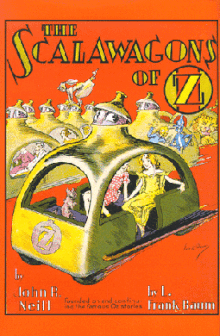The Scalawagons of Oz

Cover of The Scalawagons of Oz.
|
|
| Author | John R. Neill |
|---|---|
| Illustrator | John R. Neill |
| Country | United States |
| Language | English |
| Series | The Oz books |
| Genre | Children's novel Fantasy |
| Publisher | Reilly & Lee |
|
Publication date
|
1941 |
| Media type | Print (Hardcover) |
| Pages | 309 pp. |
| Preceded by | The Wonder City of Oz |
| Followed by | Lucky Bucky in Oz |
The Scalawagons of Oz (1941) is the thirty-fifth in the series of Oz books created by L. Frank Baum and continued by his successors; it is the second volume in the series both written and illustrated by John R. Neill.
The antagonist of Neill's plot is a mysterious monstrosity called Bell-snickle. (The term "villain" is an overstatement, since the creature is mostly a pest, or as the Wizard calls it, a "nuisance.") It first appears as "a large bluish-green object, flat as a buckwheat cake, and rolling along on its edge like a cartwheel." The creature does have arms and legs, as well as facial features; it wears bells on its ears, explaining at least one portion of its name. (The thing has no apparent relation to the Belsnickel of Christmas lore, except their common nomenclature.)
Neill gives no account of Bell-snickle's origin and no explanation of its nature or abilities. The creature prides itself on being a "mystery," and attacks anything that shares that designation. It has the egotism and petulance of a spoiled child.
In Scalawagons, Neill exploits two characters he introduced in his previous book, The Wonder City of Oz, Number Nine and Jenny Jump. Jenny is the book's protagonist, though the story begins with Number Nine, who is now an assistant to the Wizard of Oz. The Wizard has a tendency to disappear suddenly, as he pursues various projects. His latest project is the creation of a new form of transportation for the Land of Oz. In a red-domed facility atop Carrot Mountain in the Quadling Country, the Wizard has established a factory to build scalawagons, intelligent cars that can also fly. (They spread their running boards like wings.) In his illustrations, Neill makes them resemble the "kiddie cars" of amusement-park rides; their heads are in turrets on their roofs.
...
Wikipedia
